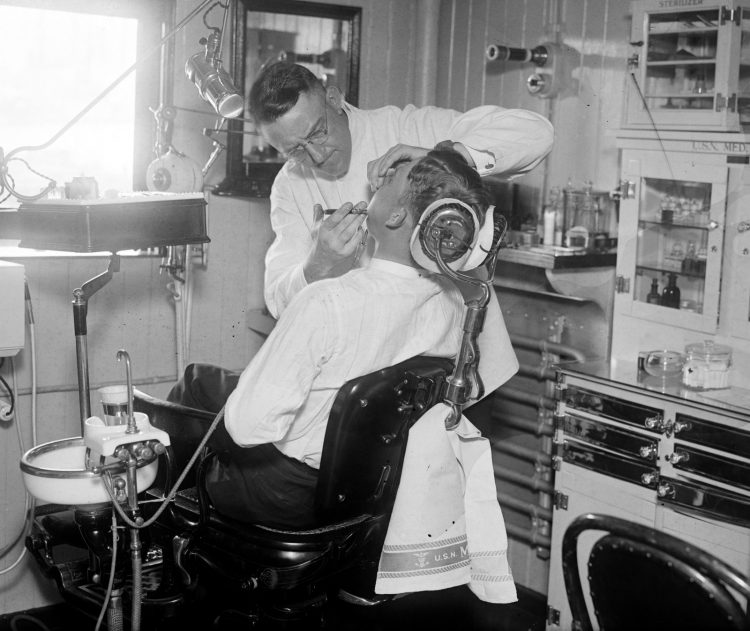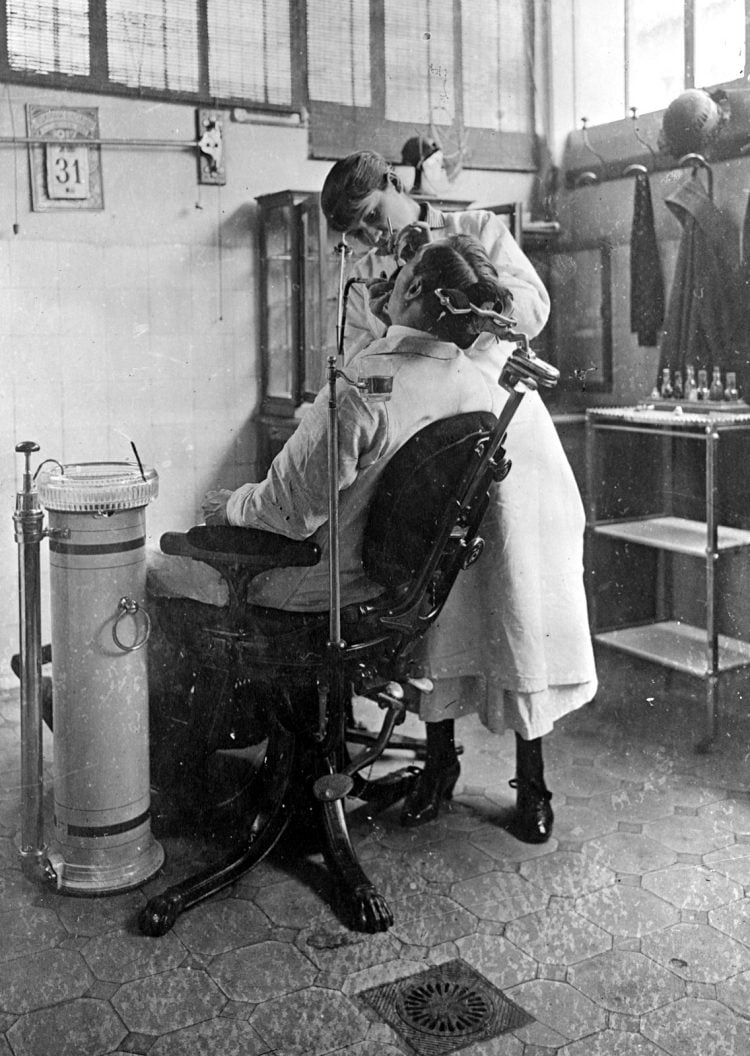Early dental care was done with simple, low-tech tools — so, as you can imagine, fear of pain kept a lot of people out of dentists’ chairs (even though some practitioners offered cocaine as a painkiller).
Particularly in the late 1800s and early 1900s, people would wait for years to go to the dentist — often only relenting when a toothache got so bad that they could no longer avoid it.

In 1919, San Francisco dentist Dr E R Parker wrote, “Back in 1889, such a thing as the practice of ‘painless dentistry’ was unknown. Nobody had a tooth pulled until the tortures of pain actually drove him to a dentist.”
Of his early career, he continued, “That I would ever be able to take a tooth out without causing pain never entered my mind.”
Fortunately, around 1905, Novocaine entered the picture, making patients much more comfortable… but it took a lot to convince people that it worked.
It was a tough sell, because for years, ads like these (from 1900 and 1893) had been promising painless dentistry:

And it’s not just dental care that’s improved over the last century — so has everyday tooth care.
Even in the twenties, commercial toothpaste existed, but wasn’t yet popular. Most people used something called a tooth powder — which might include tasty stuff like precipitated chalk, orris root, borax, powdered castile soap, and pulverized pumice — that was either purchased at a store or homemade.
Here, we take a dive into the past, and show you what going to the dentist was like around 100 years ago. Just seeing these old pictures will probably make you want to brush your teeth and schedule that overdue checkup.

Dental care and how to care for your teeth, according to people back in 1914
Article from the Burlington Free Press (Burlington, Vermont) June 29, 1914
Only pretty teeth can make a smile captivating
Bridge work, crowns and other devices repair the ravages that carelessness and neglect in early years have wrought in a good set of teeth, and there is no excuse, these days, except that of arrant cowardice, for having to keep one’s mouth from smiling because of poor teeth within.

After all, most of us discover, it is the prospect of visiting the dentist that is appalling — not the actual hours in his dreaded chair.
Once the courage is nerved up and the first appointment made and kept; one is very likely to declare to one’s own particular confidant — who has probably been bored for weeks, if not months, by the imminent necessity of one’s prospective visit to the dentist and one’s sickening dread and consequent procrastination — that “after all, I don’t know why I was so nervous. With these modern electrical devices and gold inlay fillings, all made outside of your mouth, the thing isn’t really so bad…”
Right care of the teeth presupposes a visit to the dentist’s at least once a twelvemonth to have them looked over and put in good condition. Once in six months is even better, if one can muster up a six-months courage and cares to give the time to the matter.
ALSO SEE: Fact & fiction about George Washington’s teeth – and why they were so controversial

Use the toothbrush thrice a day, and be fastidious in its selection
Care of the teeth means also systematic and thorough cleansing of each separate tooth twice or three times a day with toothbrush and water.
A good tooth paste or powder should be used once a day, and raw silk passed between the teeth when they grow closely together will help to keep particles of food from lodging between them and causing decay.
Rinsing the mouth with Listerine and water, or dioxygen and water will also help to ward off decay of the teeth, for sometimes the condition of the system and particularly digestive troubles in the stomach will cause quick decay of the teeth even when they are carefully brushed.

The toothbrush should be renewed the moment it becomes soft and the bristles loosen. A moderately stiff brush should be selected, though the use of a curved or straight brush is a matter of choice.
Some brushes suit one mouth, some another. As a rule, however, the curving brush does the most thorough work. Three rubs across the front teeth do not constitute a “thorough brushing.”
Thirty rubs will be a fair allowance, but fifty will do the business in much more satisfactory — that it is to say, beneficial, manner.
The brush should be passed over the back teeth. Inside and outside, and an upward and downward movement of the brush — especially on the front teeth — will achieve better results than a crosswise movement which merely polishes the surfaces and leaves the crevices between the teeth untouched.

Some teeth do not acquire tartar easily; other teeth will become discolored, even with constant brushing, very quickly.
If the half-yearly visit to the dentist does not keep the teeth free of tartar, cleanse them once a month with powdered pumice moistened with diluted peroxide or dioxygen.
ALSO SEE: How X-ray shoe fittings used to really be a thing years ago
Wrap a bit of absorbent cotton around an orange stick, dip in the powdered pumice and apply to the teeth, rubbing gently until the tartar is removed.
If there is the slightest tendency towards receding gums, consult a dentist at once, Nothing ages a face more surely than the elongated teeth caused by a receding of the gums.
This trouble, called Riggs disease, is seldom found in youth, though it may make its appearance early in the thirties. If not checked in time it may mean the loss of all the front teeth, and at best crooked and misshapen teeth.

Gold fillings should be avoided in the front teeth whenever possible, for a glittering golden smile is considered bad form these days.
Gold inlays and fillings are advisable for back teeth if the work can be afforded, but even if porcelain fillings have to be renewed now and then, they are much more becoming, because of their inconspicuousness, in front teeth.
If false teeth of any kind are necessary, consult the very best dentist you know of. Don’t try to economize on your smile. Pay whatever price is necessary, at cost of whatever other sacrifice, to secure the highest grade of dental work in this respect.
Vintage Pepsodent toothpaste ad (1927)
Keep film off your teeth: The supreme dental urge of today in combating tooth and gum troubles, and in correcting dull, “off-color” teeth

Old-fashioned dentistry : How they explained the causes of tooth decay in 1910
Article from The Los Angeles Herald (Los Angeles, Calif.) October 30, 1910
Of all the tissues of the body, the dense, glistening enamel which coats the crowns of the teeth is the hardest and most impenetrable. No bone tissue approaches enamel in density.
Yet, as most of us know to our sorrow, even the dental enamel is subject to decay; and, what is worse, decay which nature makes not the slightest effort to repair.

When any other tissue of the body is destroyed by violence or disease, a more or less successful and wholly spontaneous process of repair sets in, but not so with destroyed enamel. Hence the profession of dentistry.
But what is the cause of caries, or decay? This query introduces one of the puzzles of pathology. At one time, caries was attributed to chemical action of acids eructated from the stomach and to acids occurring in the oral cavity. But this notion has been abandoned.
ALSO SEE: How X-rays were discovered – Victorian medical tech we still use every day

Miller of Germany has probably given the causation of dental caries more study than anyone else.
And he is probably correct in his belief that the tooth destruction is due to the activities’ bacteria. But his view of the particular way in which the germs affect the teeth is not accepted by other recent investigators. He holds that the bacteria liberate lactic acid and that this acid attacks the enamel and underlying tooth substance.

But a prominent investigator of Harvard University has isolated and studied the behavior of about fifty varieties of bacteria commonly found in decayed teeth, and he reports that only about one-fifth of them produce lactic acid, and that even they do not produce it stronger than one-half of 1 percent — a solution far too weak to affect the teeth.
It is curious to note in passing that while Miller in Germany is attributing the decay of one part of the body to lactic acid, Metchnikoff, in France, is attributing the long life of the whole organism to this same acid.

All agree, however, that the accumulations of food particles between and around the teeth favor the development of bacteria and consequent decay.
Consequently, whatever the modus operandi of the germs may be, all we have to do — all we can do, rather — is to keep food from between the teeth by the use of floss silk and tooth brush and to restrain bacteria by the aid of mild antiseptic mouthwashes.
It has been observed that those teeth least used are more prone to decay. Accordingly, the spread of the breakfast cereal may make more work for the dentist. The teeth need exercise to keep healthy.

Dental surgery anesthesia from back in 1906
MORE: Cocaine-laced Coca-Cola was really a thing – here’s the story

See what old-fashioned dentistry was like more than 100 years ago

Forsyth Clinic, Boston – Dental work for departing soldiers (1916)
These soldiers, who were about to go fight in WWI, got their dental work done while holding their rifles.


ALSO SEE: 1918’s Spanish flu: A dark history of the deadly influenza pandemic 100 years ago
Old-fashioned orthodontic treatment methods from 1906



Vintage orthodontists: An old dental jaw dilator (1922)

Vintage equipment dentists & orthodontists used (1923)


DON’T MISS THIS: See vintage drugstores 100 years ago, selling lots of things you can’t (legally) buy anymore




















One Response
Love the site. Especially love the rubber dams with the head straps!